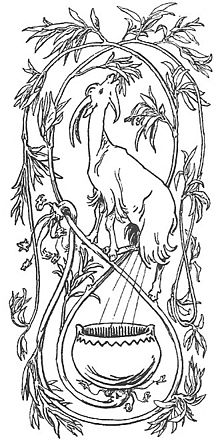Heiðrún
This article needs additional citations for verification. (October 2013) |

Heiðrún or Heidrun is a goat in Norse mythology, who consumes the foliage of the tree Læraðr and produces mead for the einherjar. She is described in the Poetic Edda and Prose Edda.
Prose Edda[]
|
Geit sú er Heiðrún heitir stendr uppi á Valhöll ok bítr barr af limum trés þess er mjök er nafnfrægt, er Léraðr heitir, en ór spenum hennar rennr mjöðr sá er hon fyllir skapker hvern dag. Þat er svá mikit at allir einherjar verða fulldruknir af. - [1] |
A goat called Heiðrún stands up [on its hind-legs] in Valhalla biting the buds off the branches of that very famous tree which is called Lærað. From her teats runs the mead with which every day she fills a cauldron, which is so big that all the Einherjar can drink their fill from it. - Young's translation |
Poetic Edda[]
In the Poetic Edda Heiðrún is mentioned twice. She is described in the Grímnismál in a way similar to Snorri's description.
|
|
Since Snorri quotes other strophes of Grímnismál it seems reasonable to assume that he knew this strophe too and used it as his source for his description of Heiðrún.
In the Hyndluljóð the giantess Hyndla (lit. bitch/she-dog) used the term "Heiðrún" to insult the goddess Freyja. Thorpe and some other translators translated the name straight to "she-goat".
|
|
Etymology[]
The etymology of Heiðrún remains debatable.[2] Anatoly Liberman suggests that Heiðþyrnir, the name of the lowest heaven in Scandinavian mythology (from heið "bright sky"), was cut into two, and on the basis of those halves the names the heavenly goat Heiðrún and of the heavenly stag Eikþyrnir were formed (the element rún ~ run concealed several puns, but it is a common suffix of female names).[3] The etymology of the New High German name Heidrun is also debatable.
Heiðrún's name is sometimes anglicized Heidrun, Heidhrun, Heithrun, Heidrún, Heithrún or Heidhrún.
See also[]
- Auðumbla, a primeval cow in Norse mythology whose udders produce four rivers of milk, from which Ymir fed
- List of people named Heidrun
Bibliography[]
- Bellows, Henry Adams. Translation of the Poetic Edda.[4]
- Eysteinn Björnsson (ed.) (2005). Snorra-Edda: Formáli & Gylfaginning : Textar fjögurra meginhandrita.[5]
- Hollander, Lee M. (1962). The Poetic Edda. Austin: University of Texas. ISBN 0-292-76499-5.
- Jón Helgason (Ed.). (1955). Eddadigte (3 vols.). Copenhagen: Munksgaard.
- Liberman, Anatoly (2016). In Prayer and Laughter. Essays on Medieval Scandinavian and Germanic Mythology, Literature, and Culture. Paleograph Press. ISBN 9785895260272.
- Young, Jean I. (1964). Snorri Sturluson : the Prose Edda. Berkeley: University of California Press. ISBN 0-520-01231-3.
References[]
- ^ "Gylfaginning 38-43". Hi.is. Archived from the original on 2009-01-23. Retrieved 2013-10-19.
- ^ Liberman (2016:337–346).
- ^ Liberman (2016:345).
- ^ [1] Archived July 16, 2009, at the Wayback Machine
- ^ "Gylfaginning". Hi.is. Archived from the original on 2008-06-11. Retrieved 2013-10-19.
| Wikimedia Commons has media related to Heiðrún. |
- Creatures in Norse mythology
- Mythological caprids
